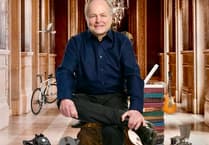A PANEL explaining the history of the development of Sedbury following the arrival of the army in the area exactly 100 years ago has been unveiled.
Before the development of a shipyard at Beachley in 1917, Sedbury was a loose collection of farms and one major building in Sedbury Park House.
The new interpretation panel, which has been mounted on the side of the Towngate Surgery in Beachley Road, is part of a longer project in Tidenham parish commemorating the centenary of the First World War.
The panel was developed by members of
the Tidenham Historical Group, funded by Tidenham Parish Council and the Mopla Cottages Trust, and framed and mounted by Bill Kerr and Gerald McBride.
It was officially unveiled by historical group chairman Keith Underwood – who was born into a Sedbury army family – and parish council chairman Cllr John Powell.
It consists of maps of the area showing when buildings were erected and is surrounded by coats of arms and symbols of events which was painted by Mr Underwood.
The research and photographs for the information on the panel came from the work by Carol and Richard Clammer for their book, published earlier this year, on the
development of the Beachley shipyard and the evacuation of families living there to make way for it.
The route of the extensive railway lines down to the shipyard are shown and there is a trail to follow around the area showing which buildings date from the First World War, including those which still survive.
Mr Underwood said: “Before the First World War, Sedbury consisted of just Badhams Court, The Meads, Tump Farm, Sedbury and Pennsylvania Farms together with a number of cottages close to the old smithy on Sedbury Lane and a second group along Beachley Road near the entrance to Sedbury Park.
“It really was a very rural community.”
All that changed in 1917 after the government decided to build a shipyard at Beachley to combat the loss of shipping to German U-boats.
Mr Underwood also explained how houses were built in Sedbury between the wars for military families who came to Beachley.
He added: “What we have in the development of Sedbury since then is a really interesting collection, architecturally, of buildings.”
The surgery is on the site of a large army hut which is well remembered among older residents as the Cherry Tree Café and shop during the 1950s.
Mr Powell, who was also born in the village, described the new board as “wonderful” and he described how, as a youngster, he had to take a long detour around the army camp in Grahamstown Road – showing identification to soldiers – to get home to Edmond Road.
There were thanks to Towngate Surgery for allowing the board to be erected on its building, to Sheila Bollen and Michelle for refreshments, to the parish council and trust for funding and to Mr McBride and Mr Kerr.
Among the events planned for next year is the centenary of what is now Sedbury Village Hall, another at Tidenham Church in the summer and an Armistice Day service on November 11.




